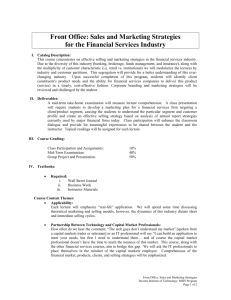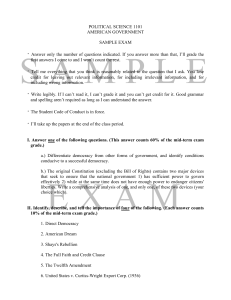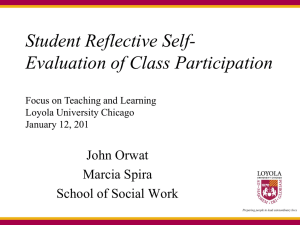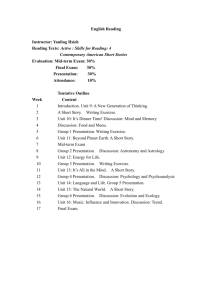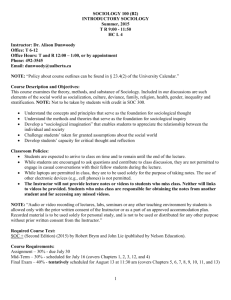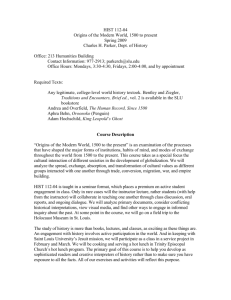Syllabus - Mysmu .edu mysmu.edu
advertisement
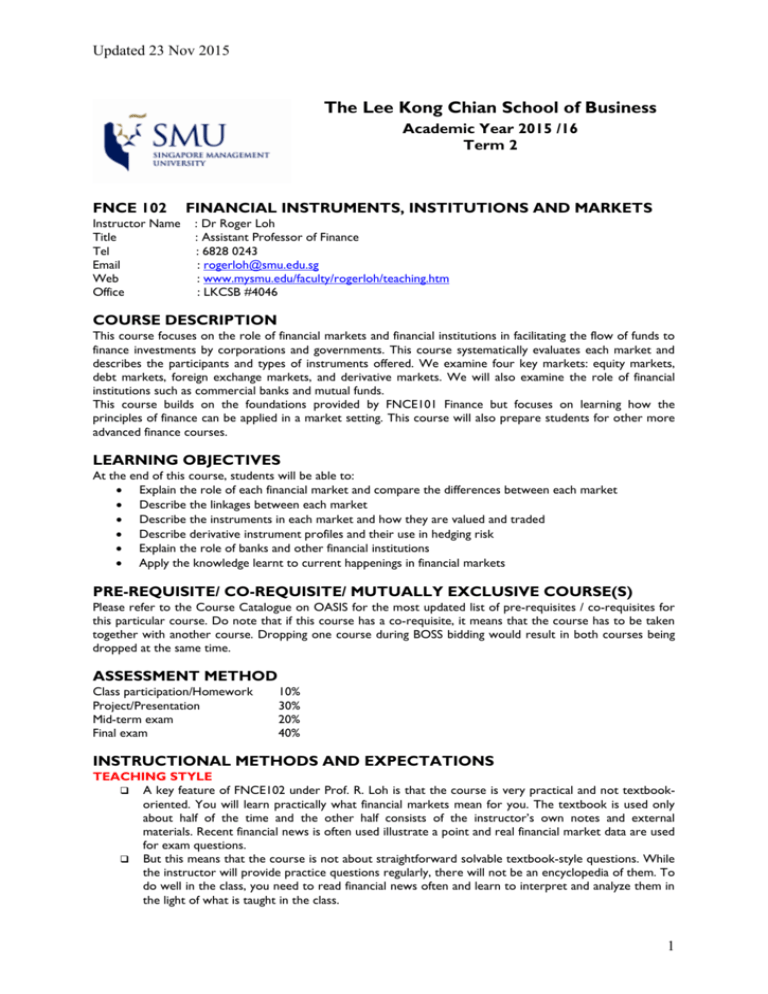
Updated 23 Nov 2015 The Lee Kong Chian School of Business Academic Year 2015 /16 Term 2 FNCE 102 Instructor Name Title Tel Email Web Office FINANCIAL INSTRUMENTS, INSTITUTIONS AND MARKETS : Dr Roger Loh : Assistant Professor of Finance : 6828 0243 : rogerloh@smu.edu.sg : www.mysmu.edu/faculty/rogerloh/teaching.htm : LKCSB #4046 COURSE DESCRIPTION This course focuses on the role of financial markets and financial institutions in facilitating the flow of funds to finance investments by corporations and governments. This course systematically evaluates each market and describes the participants and types of instruments offered. We examine four key markets: equity markets, debt markets, foreign exchange markets, and derivative markets. We will also examine the role of financial institutions such as commercial banks and mutual funds. This course builds on the foundations provided by FNCE101 Finance but focuses on learning how the principles of finance can be applied in a market setting. This course will also prepare students for other more advanced finance courses. LEARNING OBJECTIVES At the end of this course, students will be able to: • Explain the role of each financial market and compare the differences between each market • Describe the linkages between each market • Describe the instruments in each market and how they are valued and traded • Describe derivative instrument profiles and their use in hedging risk • Explain the role of banks and other financial institutions • Apply the knowledge learnt to current happenings in financial markets PRE-REQUISITE/ CO-REQUISITE/ MUTUALLY EXCLUSIVE COURSE(S) Please refer to the Course Catalogue on OASIS for the most updated list of pre-requisites / co-requisites for this particular course. Do note that if this course has a co-requisite, it means that the course has to be taken together with another course. Dropping one course during BOSS bidding would result in both courses being dropped at the same time. ASSESSMENT METHOD Class participation/Homework Project/Presentation Mid-term exam Final exam 10% 30% 20% 40% INSTRUCTIONAL METHODS AND EXPECTATIONS TEACHING STYLE A key feature of FNCE102 under Prof. R. Loh is that the course is very practical and not textbookoriented. You will learn practically what financial markets mean for you. The textbook is used only about half of the time and the other half consists of the instructor’s own notes and external materials. Recent financial news is often used illustrate a point and real financial market data are used for exam questions. But this means that the course is not about straightforward solvable textbook-style questions. While the instructor will provide practice questions regularly, there will not be an encyclopedia of them. To do well in the class, you need to read financial news often and learn to interpret and analyze them in the light of what is taught in the class. 1 Updated 23 Nov 2015 PROJECT The project will require an analysis of an issue or a topic in financial markets. The question will be provided by the instructor. You need to use financial databases such as Datastream/Eikon/Bloomberg to collect the required data for analysis. A class in week 2 will teach you how to use such databases. Each group will consist of about 5 students so that each section has a maximum of 8 groups. You may be reassigned to other groups within the section if your group is too big. In week 3 groups will decide whether to do project 1 (presented in week 6) or project 2 (presented in week 12). If needed, we will ballot to ensure an even number of groups per project. The topic will be given to you about 3 weeks before the presentation and is due on Wednesday noon of the week which you are scheduled to present. The report and slides must be uploaded to elearn by the deadline. During the presentation, please print a copy of the presentation slides and report for the instructor. The printed copies should be bound in any fancy way—just staple the pages together. The project report must be in the following format: The main content including charts and tables must be kept to a maximum of 5 A4 pages in length (with font size 12 and 1 inch margin all around, single spacing). If you really have extra materials, you can put it in an appendix. An auto-generated table of contents. A references page detailing all the sources which you utilized in your research. Include web links for internet articles. A footnote if you quote verbatim (i.e., word-for-word) from any source. Use double quotation marks to identify the phrase or paragraph quoted. The presentation will contribute 10 points and the project 20 points. Each group will have strictly only 25 minutes (15 mins presentation 10 mins Q&A) to present the project in class with all members presenting. Students from other sections who are presenting later in the week cannot sit in to watch the presentations of groups in earlier sections. During the Q&A, only students, not the instructor, can ask questions. After the presentation, peer review within each group will be conducted to determine how to share 1 bonus point according to each student’s contribution to the project. More details will be given in class. EXAMS Mid-term exam, Wednesday 2 March 2016, 8-10pm, SOA Ngee Ann Kongsi Auditorium Final exam, Tuesday, 19 April 2016, 1-4pm, Venue to be announced All exams in Prof R. Loh’s FIIM classes will be open book (you can bring books, class notes, your own notes, etc., but no laptop or smartphone). There will be one final exam and one mid-term exam. The mid-term exam will cover the bonds and equities topics and will occur in the week after the mid-term break. The final exam will cover all topics. For accreditation purposes, the FNCE102 final exam is 3 hours and will not have more than 30% of MCQs. TEACHING ASSISTANTS Shaun TAN Yi Rong shauntan.2013@business.smu.edu.sg CLASS TIMES G1 G2 G3 Wednesday Thursday Thursday 12:00-15:15 8:15-11:30 15:30-18:45 LKCSB Seminar Rm 3.2 LKCSB Seminar Rm 2.3 LKCSB Seminar Rm 2.3 ACADEMIC INTEGRITY All acts of academic dishonesty (including, but not limited to, plagiarism, cheating, fabrication, facilitation of acts of academic dishonesty by others, unauthorized possession of exam questions, or tampering with the academic work of other students) are serious offences. All work (whether oral or written) submitted for purposes of assessment must be the student’s own work. Penalties for violation of the policy range from zero marks for the component assessment to expulsion, depending on the nature of the offence. 2 Updated 23 Nov 2015 When in doubt, students should consult the course instructor. Details on the SMU Code of Academic Integrity may be accessed at http://www.smuscd.org/resources.html. ACCESSIBILITY SMU strives to make learning experiences accessible for all. If you anticipate or experience physical or academic barriers due to disability, please let me know immediately. You are also welcome to contact the university's disability services team if you have questions or concerns about academic provisions: included@smu.edu.sg. Please be aware that the accessible tables in our seminar room should remain available for students who require them. RECOMMENDED TEXT AND READINGS Financial Markets and Institutions by Anthony Saunders and Marcia Cornett 6th edition, 2015, McGraw Hill Getting a used version of an older edition is fine too since I refer to the textbook only half of the time. Chapter numbers below are based on 6th edition (5th edition has similar chapter numbers) WEEKLY LESSON PLANS Tentative: Please refer to http://www.mysmu.edu/faculty/rogerloh/teaching.htm for updates. Week Topic Outline 1. Intro/Equity Week 1 class is on Sat 9 Jan 2016 at LKCSB SR 3.2 Markets 1 G1: 8:30AM-11:00AM G2: 12:00PM-2:30PM G3: 2:30PM-5:00PM This is because Prof R. Loh is attending the American Finance Association conference in San Francisco from Jan 1-8. 2. Financial Database class 3. Equity Markets 2 4. Equity Markets 3 Chap. 1, 8 Overview of FNCE102 Equities 1: Stock Indices Types of stock market indices Index construction methodologies Conducted by the Library. Learn how to collect financial data using financial databases. Sign up according to your class times. Session timings to be announced. Do financial database homework Equities 2: The Stock Market Issuing Stock: IPOs, Underpricing Rights issue and trading Trading Stock: Types of markets and orders Margin trading/Short selling Equities 3: Mutual funds Mutual funds, unit trusts Exchange traded funds Fund costs analysis Fund performance measures Special topic: How should retail investors invest? 8 17 3 Updated 23 Nov 2015 Week 5. Topic Bond Markets 1 Outline Bonds 1: Bond pricing and term structure Yield computations Determinants of yields Money market instruments (Day/year conventions) Term structure of interest rates Duration and convexity Bond auction pricing mechanisms (SGS bonds) Chap. 2, 3, 5 6. Project Presentations 1 and Bond Markets 2 Project Presentations 1 3,6 7. 8. Foreign Exchange Markets No class except for mid-term exam 10. Financial Institutions 11. Derivative Markets 1 12. Project Presentations 2 & Bonus Lecture Derivative Markets 2 14. 16. Accrued interest Clean price and dirty price Discussion of project 1 Forex markets Spot and cross rates Currency trading Triangular arbitrage Forward markets Parity conditions International parity conditions Covered interest arbitrage Carry-trade and risk aversion 9 Review for mid-term exam Mid-term break, no class. 9. 13. Bonds 2: Mid-term exam (covers equities and bonds only, Open-book exam without laptop): Wednesday 2 March 2016, 8-10pm, SOA Ngee Ann Kongsi Auditorium. Financial Institutions Commercial banks Securitization Investment banks 11, 16 Derivatives 1: Futures and options Futures versus forwards Pricing futures contracts Margin requirements of futures Call and put options Determinants of option value Project presentations Bonus lecture: Real estate and insurance markets 10 Discussion of project 2 10 Derivatives 2: Options strategies and interest rate derivatives Option strategies Forward rate agreements Interest rate swaps Review for final exam Study break Final Exam (covers all topics, Open-book exam without laptop) Tuesday, 19 April 2016, 1-4pm, Venue to be announced 4
